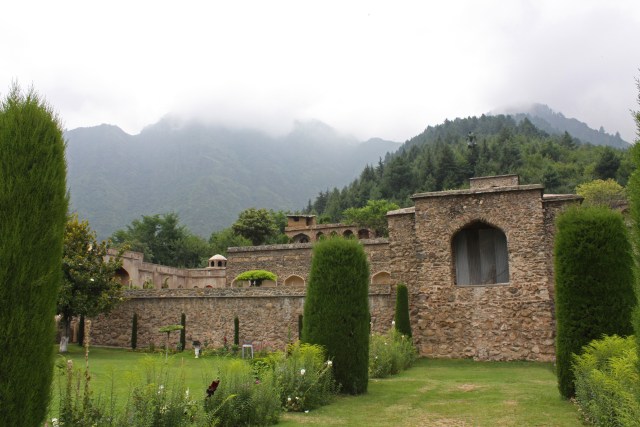
The recent floods arising from the collapse of a dam in northeast India reminded me of an experience with floods in the Western Himalayas over ten years ago. My son and I had arranged to go trekking in Ladakh in Kashmir with some people I had met the previous year on a fundraising trek in southern India. We had a few days in Delhi before flying to Srinagar. Here we began our high-altitude acclimatisation. Srinagar is at 1585m and while staying on a houseboat on Lake Dal

we visited three Mughal Gardens and had a walk up to 2,000m.

Time had come for us to leave and travel overland in a bus to Kargil and then onward to Leh.

We passed the High Altitude Warfare School and drove over the Zojila pass at 3,528m. En route we stopped at Sonnamarg, an alpine meadow at 2615m with glacier and had to wait for a convoy before we could leave.

We were not far from the line of control. Near Dras the bus had a puncture.

We eventually arrived in Kargil for the night. Kashmir is predominantly Muslim so the muezzin is a reliable early morning alarm and we set off over the highest point on the Srinagar to Leh road: the Fotu Lah pass at 4,108m.

After another puncture and the bus getting stuck on hairpin bend and having to be dug out, we arrived in Leh at 10pm. Ladakh is 80% Tibetan Buddhist and before we left on our trek, we spent a day exploring Thikse Monastery, Leh Palace, Stokna Gompa and Shanti Stupa.The following morning, we visited Spituk Monastery and then walked to the pony meet at Spituk Bridge to join up with the pony train which transported our tents and all our camping equipment. Spituk Bridge is at 3,214m.

The first part of the Markha Valley trek was a hot walk in the sun.

After lunch we descended into Zingchen Gorge which was more sheltered and camped at Zingchen at 3,396m. The following day we walked to Yurutse and I began to suffer from altitude sickness and central cyanosis so I rode on the horse for the last part of the day. We camped at 4,150m. Our third day was a very hot climb up to the Ganda La pass at 4,900m. I crossed this on the horse and sat at the top admiring the view before the others arrived.

After a long, slow descent we arrived at Skiu, a small village at 3,500m. We had a relatively lazy day with some yoga and a short walk to the local gompa.
Heavy rain the next morning flooded one tent and delayed our start. The following night there was a major storm and a mudslide. Getting to Markha was impossible as the river was now too deep to cross so we returned to Skiu. Storms continued and we had to evacuate our tent at 3am because the river flooded due to a flash flood coming down the gorge.

This swept part of the village away and some trekkers died in the gorge. We spent the next few days trying to keep a supply of fresh sterilised water when the spring was accessible, treating injured people and giving a hygiene talk to the assembled 150 foreign youth and 40 Kashmiri support staff living in very basic conditions which meant that any infection would spread quickly. One of the villages had a radio and we heard an English Indian News broadcast which said that flooding and landslides were widespread in Ladakh and that 150 had been killed and 800 were missing. We should have left the National Park but could not so would be counted among the missing. An attempt was made to cross the landslide to the next village where there was a satellite phone to make contact with our relatives. Many lines were down but contact was made with a couple of people. Later, contact was only with Leh and Srinagar but they could not call internationally. The floods had become much more widespread and Jammu and Kashmir had declared a state of emergency. Pakistan had over 10,000 dead. We were promised a food and medicine drop (we had enough for seven days in our group and had started rationing). One of the Romanians had died but we could not bury the body as one day was inauspicious according to the locals and there was not enough depth of soil in the valley to dig a grave. Air burials are the norm in Ladakh: the Muslim person in the village will cut the body up and it is placed on a stone altar in the mountains and left to the birds. This was not acceptable to the person’s companions. There were more storms and a further flash flood. At 5am one morning we were woken by the sound of a helicopter. It was too small to be a food and medicine drop and turned out to be a stripped-down Puma helicopter which could fly at high altitudes belonging to the Indian Air Force. It had come to rescue us. It took three of us at a time and we could only take a small rucksack. We got back to Leh; caught a plane to Srinagar and then to Delhi and managed to make our booked flight back home.


Carol,
Stunning views and eventful trip.
Femi
Thanks. Once we got back we sent some money via Save the Children to help the small community that sheltered us.
Wow! So glad you were able to help others and make it back safely!